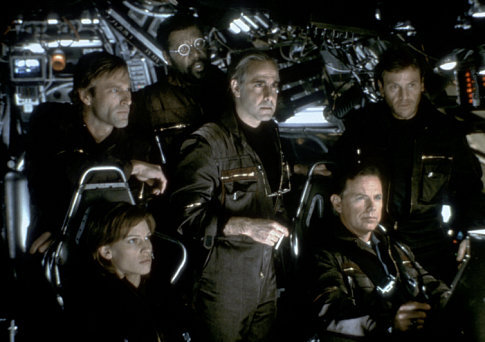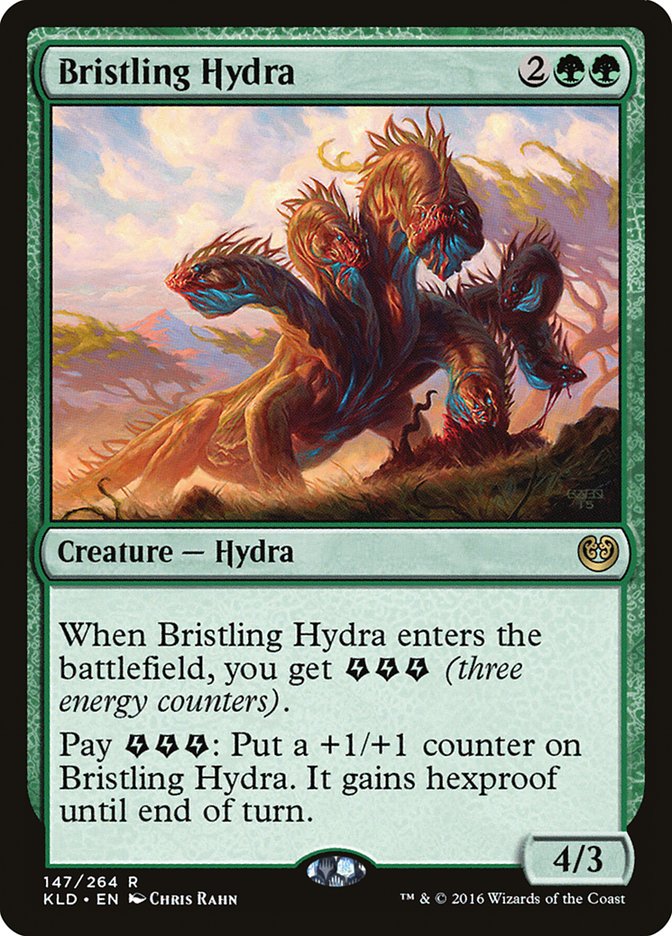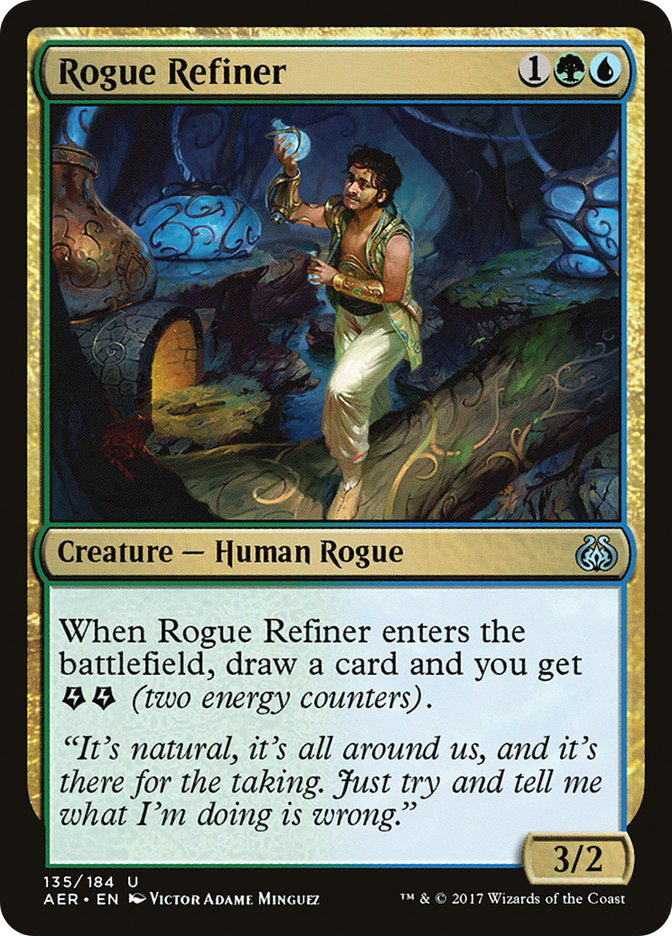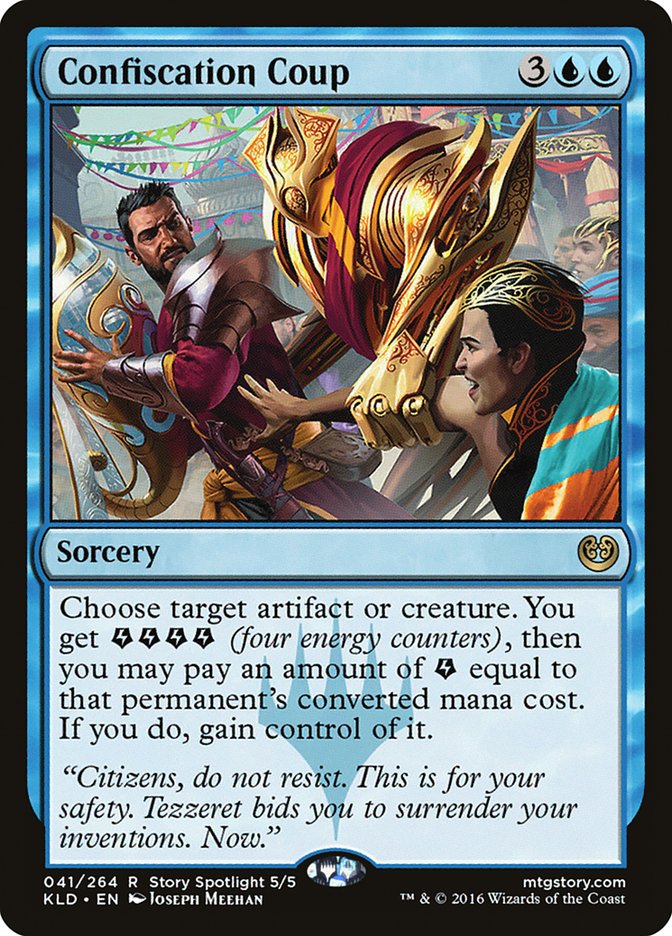A few days ago I found myself in a brief debate on Twitter. If you check out the link, you’ll discover it’s about differing opinions on Bristling Hydra.
What was shocking about this discussion is that everyone seemed so animated about their opinion, almost as if there was no way to resolve the issue. It wasn’t until it was almost over that I discovered the argument we should have been making was whether the splash for black was worth it. That conversation never took place, but got me to thinking. I know everyone’s sick of Standard, but this debate is worthy of one more go-around for anyone still playing the format.
Is The Scarab God worth it in Temur?
To get started on this convoluted question, we must first start breaking down each version of the deck. For starters, I see two variants of Temur. Any other variants I would consider Four-Color Energy, completely different from the main talking point for this conversation. For example, this is a Four-Color Energy deck that we are not discussing.
Creatures (22)
- 3 Gonti, Lord of Luxury
- 4 Whirler Virtuoso
- 4 Servant of the Conduit
- 4 Glint-Sleeve Siphoner
- 4 Rogue Refiner
- 3 The Scarab God
Planeswalkers (2)
Lands (22)
Spells (14)

Now, I take a pretty hard stance when it comes to this debate. I dislike the black splash. I did play the fourth color at the World Championship earlier this year, but that was caused by ignorance. The moment decklists were public, I realized how big of a mistake it was due to everyone else playing Temur Energy having a good plan against the card.
I never once activated its ability. Not once. Ever since then I’ve only played straight Temur.
To be fair, I did almost splash again for Pro Tour Ixalan, but that was back when I thought decks like Esper Tokens, God-Pharaoh’s Gift, and other nonsense would be more popular. As the metagame corrected itself before the event, I moved off it and onto Sultai Energy.
At this point the splash of black mainly provides inevitability through Vraska, Relic Seeker and The Scarab God. The added benefit is that these cards can also be played early in the game to press an advantage, causing the game to practically end. When the deck is firing on all cylinders, the splash for black looks incredible.
Other times, these cards are severe liabilities. On the surface, The Scarab God is just a 5/5. Sometimes it will get Confiscation Couped, ignored by Bristling Hydras, or flown over by Glorybringers. It doesn’t really impact the game until you untap with it. The tempo swings with end-step Harnessed Lightnings are also backbreaking at times.
The biggest on-the-surface cost for playing these cards is that they are not that great against the rest of the field. Sometimes the planeswalkers can help win a game against U/W Approach that Temur is incapable of, but neither of these cards is great against Ramunap Red. The main reason to splash black is for the mirror, but does it actually improve the matchup? Many think that to be true, but I’ve come around to believing the advantage is practically negligible. Here’s why.
Creatures (22)
- 4 Longtusk Cub
- 2 Bristling Hydra
- 4 Whirler Virtuoso
- 4 Servant of the Conduit
- 4 Rogue Refiner
- 2 Glorybringer
- 2 The Scarab God
Planeswalkers (5)
Lands (22)
Spells (11)

Team CFB’s decision to only play two Bristling Hydras is what started this whole debate in the first place, but after thinking about it, that makes perfect sense when playing four colors. Against Temur Energy you have the more powerful late-game cards, and you need to cast them to get an advantage. Playing a bunch of midrange creatures isn’t going to get you there. The later the game goes, the more powerful cards like The Scarab God get, but Temur Energy’s Glorybringers barely make the impact they normally do in the earlier turns.
The true hero for Temur Energy against those who splash is in fact Bristling Hydra, as it’s the easiest way to punch through consistently, which is why Temur Energy needs more of them. Right there could be the argument why you would want to play more of them, but the team stands by their decision to prioritize Chandra, Torch of Defiance. Now I can’t get behind this decision at all, as the planeswalker is weak on the draw in the “mirror,” but also horrific against Ramunap Red and other aggressive decks. I truly believe it’s criminal to play fewer than three Bristling Hydras, but arguing that won’t get us anywhere.
What causes this conversation to get so convoluted is that the game can play out in myriad ways. Sometimes a Turn 4 Glorybringer on either side creates a ripple effect that causes the opponent to never really get back into the game. The same can be said about The Scarab God. One player may only draw Whirler Virtuoso while the other has many Rogue Refiners. Someone may even keep topdecking two-drops while the other finds haymakers. The mirror is so high-variance that pinpointing what wins games isn’t feasible. That’s why it’s been three months with this format and there’s still no consensus on what’s the best version.
What’s most interesting in the Temur “mirrors” is that any unique card played to gain an advantage can be exploited in some way. Confiscation Coup is great against Glorybringer and The Scarab God but gets embarrassed by planeswalkers, Rogue Refiners, and Bristling Hydras. Planeswalkers are weaker on the draw, as it’s difficult to stabilize with them without other support. Whirler Virtuoso can sometimes play the part, but things have to go right for that to always work.
Nothing’s great all the time. It’s important to realize this. Often I hear people trying to find a defined way to get an edge in the mirror when there just isn’t one. Not at a high enough percentage, anyway.
Sadly, there isn’t a secret formula for success in the Temur mirror, but what I’ve come around to is the idea that I want to make the deck as consistent as possible without hurting its overall power level. Cards like Confiscation Coup and Vizier of Many Faces are those cards for straight Temur, as they turn the opponent’s deck against them. Confiscation Coup isn’t as good against straight Temur Energy, as they’ll often play around it as best as possible.
On the flip side, cards like Chandra’s Defeat get much better out of the deck with the splash, as they aren’t as reliant on red permanents as their three-color counterpart. Being aware of these little intricacies can help you have more defined plans for the mirror so you don’t end up in bad situations that could have been avoided.
At this point we are going to break away from talking about the splash and focus solely on straight Temur Energy. Not only do I believe more in Temur Energy, but it’s also where I have the most foundation to educate. So let’s talk more about Temur Energy!
First off, the manabase. There are very few discrepancies outside the Forest, Rootbound Crag, and Sheltered Thicket numbers. Personally I’m a fan of this:
I’d probably play four Rootbound Crags if it weren’t that I’d rather draw one of each of the multicolor when I need to deploy both of them. Some argue that they want more Sheltered Thickets, as the deck is prone to flood, but I don’t mind flooding when the alternative is not casting Glorybringer on time. Certain builds of this deck also sideboard out Servant of the Conduit in the mirror, meaning flood will happen less often as well.
Next up is the creature base, more specifically how many Whirler Virtuosos and Bristling Hydras you play. I say that because I now believe it to be a mistake to play fewer than four Glorybringers. I can’t articulate why more than saying the best thing to play after Glorybringer is another Glorybringer. That’s why Team ChannelFireball only playing two of the card was so perplexing to me. It just feels so mediocre when the rest of the deck isn’t trying to do that very same thing.
Anyway, the decision of how many Whirler Virtuosos and Bristling Hydras you play obviously depends on other aspects of your decklist. There are so many different builds running around that it seems almost impossible to know what to do. Torrential Gearhulk started popping up again thanks to Reid Duke’s MOCS Qualifier-winning decklist. MTG Mint popularized a sideboard plan that sideboards out all the two-drop creatures and brings in four copies of Vizier of Many Faces. Then there are the lists that run a smattering of everything.
How in the world do you choose? Well, we must dig even deeper to unravel this mystery!

Best. Movie. Ever.
We start with one of the most important decisions when building the deck. How many Confiscation Coups should you play? The card is at its best against Temur Energy that splashes black, Ramunap Red, and Mardu Vehicles. When these decks are at their strongest, you want at least three copies of the card. If you really care about the aggressive matchups, you’ll also want to play at least two Magma Sprays and four copies of Abrade in the 75.
Keep in mind that Appetite of the Unnatural seems to be everywhere, but I loathe this card. It’s just too slow against decks like Mardu Vehicles. Play four Abrade instead and make room for a card like Slice in Twain for U/W Approach or River’s Rebuke for token strategies. Appetite for the Unnatural is just too underpowered for this format.
Confiscation Coup is extremely important against these new variations of Ramunap Red that support cards like Rampaging Ferocidon and Harsh Mentor. You now can’t just make roadblocks but need to deal with all their creatures. Since the game patterns have slightly shifted, so have the life totals. Now, when you stabilize, it’s on a battlefield devoid of creatures and both players have high life totals. This is a great situation for Hazoret the Fervent to take over games quickly, as you’re not in prime position to race it.
I don’t like playing all four Glorybringers when I also want three Confiscation Coups, as seven five-drops are just too many nowadays. Obviously you get to sideboard one or the other out, but supporting excess fives in the list always seems to cause the deck to miss a key card for a specific matchup. I just always feel like my deck is off by a card or two when I do that. I often regret not playing four Glorybringers, especially when I expect fewer players to splash the fourth color. If I knew I would play against more four-color variations of Temur, then I would be fine only playing three Glorybringers, as I won’t even want the third Confiscation Coup for the true mirror.
The next decision to make is how many of them make your maindeck. Some only play five cards that cost five mana, while others play six. Personally I like playing six, as the deck wants powerful cards early in the game. They just might not have the same effect drawn later. It’s also rare to play multiple four-drops one after another and be in a good position. You really want to curve up as quickly as possible. When you play six five-drops, you only want four or five four-drops and usually the full four Whirler Virtuosos. I also like one or two Magma Sprays in the maindeck. This all just helps make the deck slightly leaner.
As for the sideboard, I would never play cards like Aethersphere Harvester, Torrential Gearhulk, or Deathgorge Scavenger (even though I love that little critter). They’re all just too situational, and I’ve already talked about how much I hate high-variance cards. Torrential Gearhulk is also at its best against U/W Approach, but it’s probably worth finding something else, especially with so many Vizier of Many Faces running around that it often becomes a liability. The same can be said for Rhonas the Indomitable, and for other reasons Skysovereign, Consul Flagship. Personally, I just like the good “meat and potatoes” sideboard cards.
I’ve regretted sideboarding any other card over the past few months. To me, this is all you can choose from. River’s Rebuke was on that list, but there just aren’t enough Tokens decks running around, and it’s not great against U/W Gift.
Creatures (23)
- 4 Longtusk Cub
- 3 Bristling Hydra
- 4 Whirler Virtuoso
- 4 Servant of the Conduit
- 4 Rogue Refiner
- 4 Glorybringer
Planeswalkers (1)
Lands (15)
Spells (21)

This version of Temur Energy is best against Ramunap Red and true mirrors. That doesn’t make it bad against those who splash black, though. In the “mirrors” this version looks to sideboard out all of its two-drop creatures and have a much denser mid-game than other versions.
The hole in this version is when an opponent is firing on all cylinders. If they don’t do their most powerful thing on-curve, like Vraska, Relic Seeker or The Scarab God, this version’s density of good cards allows for more decision making each turn. Four Vizier of Many Faces also means you’ll rarely lose to something they have that you don’t, as you can copy their Whirler Virtuoso or Bristling Hydra. Just keep in mind they can make Thopter tokens and then kill their own Whirler Virtuoso if it’s relevant.
Creatures (22)
- 4 Longtusk Cub
- 4 Bristling Hydra
- 3 Whirler Virtuoso
- 4 Servant of the Conduit
- 4 Rogue Refiner
- 3 Glorybringer
Planeswalkers (2)
Lands (15)
Spells (21)

This version is geared slightly more towards Temur Energy splashing black and Four-Color Energy. Less of Glorybringer and more of Confiscation Coup makes you want to play four Bristling Hydras, making Vizier of Many Faces clunkier in higher numbers. It also needs another sideboard slot for U/W Approach, making me want the Lifecrafter’s Bestiary, as it’s good against Four-Color Energy as well.
In the end, the only “secret” I have for you is only playing with consistent cards. Temur Energy is clearly the most powerful deck, and making sure it does the same thing every game is extremely important. At least, for me it is. I highly suggest playing one of these two versions if you’re unsure of what list to play. That’s if you don’t have the uncontrollable urge to play ridiculous mythic rares that make you feel like you have the edge.







